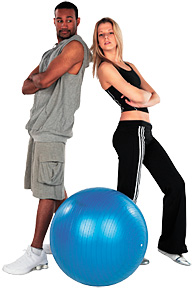Winning Without Weights
No-Nonsense Exercises to Build Core Strength and Tone Your Entire Body
By Jeffrey Tucker, DC
Your core is your center of gravity, located around your trunk and pelvis, and having a strong core is vital to good posture, muscle control, injury prevention, maximum athletic performance and even basic activities of daily living. There are a variety of ways to work the core muscles, and these days, it's not always necessary to use free weights or weight machines. Body weight, foam rolls, stability balls, bands, tubing and medicine balls are tools that can be used at home, on your own, to create a solid foundation for developing dynamic strength in your torso, shoulders, arms and legs.
For example, body-weight exercises such as squats, lunges, push-ups, and pull-ups can target the small and large muscles that influence the spine. Working out with balls and bands can help develop a lean torso and abs, build muscles in your pelvis, lower back, hips, abdomen, arms, and create flexibility. And using a foam roll can relieve tension in tight, overactive muscles.
 It doesn't take very much equipment to get started. In my own experience working out at home on a daily basis for the past 15-plus years, a disk used to move furniture becomes the perfect tool to perform sliding lunges. A chin-up bar replaces a lat machine. A chair or a bench becomes a platform to perform step-ups and step-downs. An 8 lb medicine ball can be thrown against an outside wall while performing a chest press. A padded surface or a rocker board/ balance board can be used to perform single-leg stance movements and improves joint stability. A band with handles works just as well as barbells or dumbbells. (Band training provides variable resistance to the popular exercises we use machines or free weights for, such as pressing, rowing, squatting and many others ). A stability ball can be used instead of a flat bench.
It doesn't take very much equipment to get started. In my own experience working out at home on a daily basis for the past 15-plus years, a disk used to move furniture becomes the perfect tool to perform sliding lunges. A chin-up bar replaces a lat machine. A chair or a bench becomes a platform to perform step-ups and step-downs. An 8 lb medicine ball can be thrown against an outside wall while performing a chest press. A padded surface or a rocker board/ balance board can be used to perform single-leg stance movements and improves joint stability. A band with handles works just as well as barbells or dumbbells. (Band training provides variable resistance to the popular exercises we use machines or free weights for, such as pressing, rowing, squatting and many others ). A stability ball can be used instead of a flat bench.
What exercises should beginners start with? The National Academy of Sports Medicine recommends starting a workout using the foam roll for what is known as "self myofascial release." Pressure placed on tender points within the muscle are held for 30 seconds. This allows for optimal muscle lengthening and acts as part of the warm-up phase. Next are lengthening or stretching maneuvers. After stretching only tight, overactive muscles, you then perform basic exercises and progress to advanced strength movements. Maneuvers requiring co-contraction of the small stabilizer and larger mobilizer muscles, such as the"plank" exercise (see below) are great for the abs. Pick exercises that target the front, rear and side muscles of the trunk.

